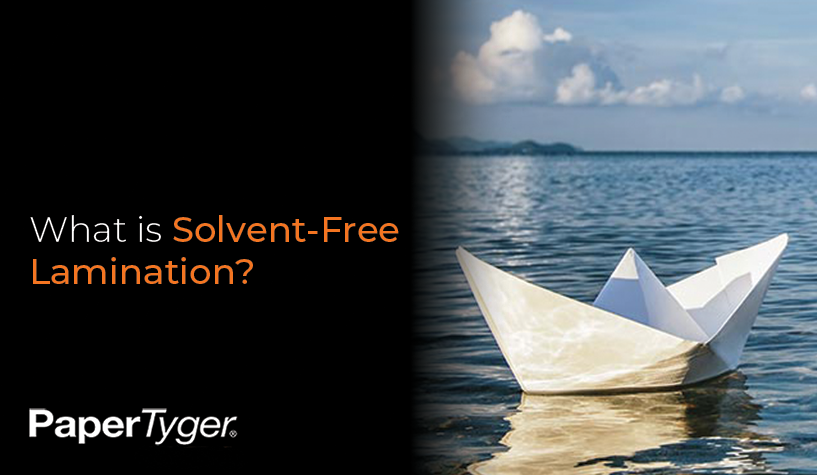“Durable paper” gets searched a lot, but what does it actually mean? For many buyers, the choice...
What is Solvent-Free Lamination?

There are a few types of lamination used in printing. Some are more advantageous than others, and this depends largely on your printing requirements and your application. This article will cover lamination processes, applications, and benefits of solventless lamination.
Find out what solventless lamination is and why it’s a great choice for your printing needs. Read on as PaperTyger explains.
What is Lamination? How does Lamination Work?
Laminating is a process that allows paper, packing labels, and more to be preserved by a type of film overlay. Lamination involves a plastic film, aluminum foil, paper, or other materials being bonded together to form a layer. Regular untreated paper is susceptible to damage when exposed to the elements, and lamination offers a form of protection to keep your printed design looking as good as the day it was printed– and for a significant period of time, too.
It’s important to note that there are different types of lamination used with different end goals in mind. For example, in the flexible packaging world, lamination is defined as the process through which two or more flexible packaging webs are joined together using a coated bonding agent. Generally, an adhesive will be applied out of either water or stronger solvents that must be evaporated during the process and applied to the paper and pressed using heat to create a two-layer laminate.
Related Article: How to Create Strong Branded Packaging
Traditional lamination printing, however, is slightly different. This process is often referred to as Thermal Lamination and involves a thin layer of plastic thermally bonded to paper or cardstock to enhance and protect the printed sheets. Common laminate finishes include gloss, matte and silk. This type of lamination is often used for packaging, book covers, brochures, business cards and other printed items.
Solventless Lamination from PaperTyger
PaperTyger paper is laminated using a solventless or 100% solids technology. This laminating method requires no ovens to evaporate solvents, nor does it use water-based adhesives. As a result, our laminated papers are simply more stable. PaperTyger's unique patented paper/film/paper laminating process means it can stand up to extreme weather and handling conditions. This solvent-free laminating process delivers the toughness of a synthetic sheet with the benefit of an uncoated printing surface because of its paper/film/paper composition.
Benefits of Solventless Lamination
Lamination in general will add strength and stiffness to paper, which enhances overall quality and durability. Additional benefits of solventless lamination processes include minimal emissions during the drying phase, shorter drying times, and less exposure to the elements as a result.
PaperTyger’s patented solventless laminating process, for example, ensures products are as durable as synthetic papers (due to the inner layer of plastic film) but with the benefits of being REAL paper on both sides. Just like PaperTyger, synthetic papers protect printed content against stains, spills, moisture, rips and tears, and contaminants (like oil, grease, and dirt). Synthetics, however, don’t produce printed results in qualities as high as standard paper. Synthetics require heat solvents to burn off laminates and this can cause the final product to curl rather than lay flat. PaperTyger paper is as durable as synthetic options, with the ease of printing and cost-effectiveness of using real paper.






